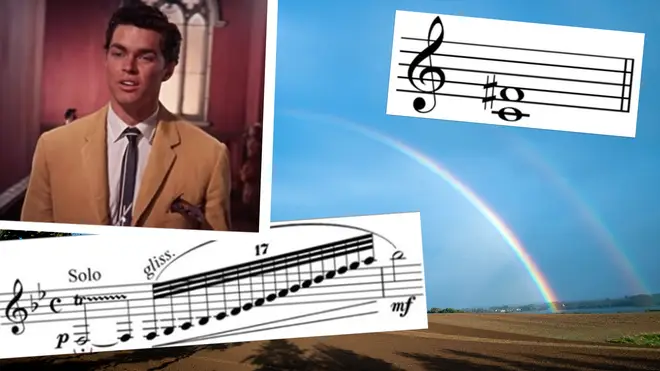The most iconic intervals EVER used in music
16 October 2019, 16:37

From the octave leap in Harold Arlen’s beloved ‘Over the Rainbow’, to that irresistible Bernstein tritone in ‘Maria’ from West Side Story, we celebrate the very best intervals found in the whole history of music.
The step between one note, or pitch, and the next is an ‘interval’.
And, like with a perfectly constructed phrase in Shakespeare – or the right dash of paint in a fine Monet – some intervals stay with us more than others.
So, without putting too fine a point on it, here are the intervals in music history we feel are the most iconic.
-
The minor second in Beethoven’s ‘Für Elise’
That repeating minor second – AKA semitone – at the beginning of Beethoven’s popular Bagatelle No. 25 in A minor (‘Für Elise’) is what makes it instantly recognisable.
Those oscillating semitones create a moment of suspense that’s perfect for the melody to jump off from elegantly, and they also pave the way for the minor key angst found in the middle section of the piece.
Another iconic minor second? John Williams’ unsettling soundtrack to Jaws. Terrifying.
-
The octave in Harold Arlen’s ‘Over the Rainbow’
Jumping forward to 1939, and Harold Arlen’s iconic ‘Over the Rainbow’, we find one of the most iconic uses of an octave jump in music.
To borrow the words of Bill Bailey – who recently told Classic FM he thinks is *the* most beautiful melody ever written BTW – it wonderfully evokes the very leap over the rainbow Dorothy in the Wizard of Oz wistfully sings about. And it sets up a darn fine tune to boot.
-
The major third in Beethoven’s Symphony No. 5
Okay, so obviously the rhythm and melody of the opening of Beethoven’s Fifth are what have made it the music equivalent of a household name. But we reckon it’s that first interval too.
The major third – opening a Symphony in C minor, no less – is instantly memorable, especially when coupled with what happens next, namely the more expected minor third.
As well as all the complicated physics of hearing and rather involved music theory behind why this is as affecting as it is, it’s a showcase in Beethoven doing what Beethoven does best – creating the angst and uncertainty in his melodies that essentially keeps us wanting more. Genius.
-
Read more: Hearing Renée Zellweger sing for the first time was ‘mesmerising’, says Judy director >
The two-octave fifth in Gershwin’s Rhapsody in Blue
The opening two notes of Gershwin’s Rhapsody in Blue are effectively ‘coloured in’ with arguably the most iconic glissando ever written (go on, name us a more iconic one).
The principal clarinettist launches the entire symphonic jazz work with a low E (G on clarinet) to high B flat (C) interval, but with the added colour of a trill, a rapid scalic run and a silky smooth slide gliss. to fill the gap.
-
Read more: This insane Rhapsody in Blue glissando is one of the best we've ever heard >
The perfect fifths in Richard Strauss’s ‘Also Sprach Zarathustra’
Strauss’s Also Sprach Zarathustra – made more famous by the opening sequence of Stanley Kubrick’s 2001: A Space Odyssey – starts with a series of intervals of a fifth.
The trumpet rings out across the orchestra, and the striking intervals are soon punctuated by percussive beats that seem to be ringing in a sense of impending action.

2001 A Space Odyssey Opening in 1080 HD
-
The augmented fourth in Bernstein’s ‘Maria’ from West Side Story
The eleventh “Maria” you hear sung in the Bernstein/Sondheim song of that name from West Side Story – the one Tony sings to launch the well-known chorus – features the spinetingling and frankly unforgettable interval of an augmented fourth, AKA a tritone.
A tritone is so dissonant that it gets called ‘The Devil’s Interval’ by those in the know, but Bernstein used it very deliberately exactly for its unsettling, unresolved feeling. Indeed, it’s surely the perfect metaphor for young love in its unsteady path to maturity.

West Side Story (3/10) Movie CLIP - Maria (1961) HD
-
Read more: Why did Bernstein build West Side Story around 'The Devil's Interval'? >
The perfect fifth followed by a major second in Handel’s ‘Hallelujah Chorus’ from Messiah
The repeated hallelujahs in the ‘Hallelujah Chorus’ from Handel’s 1741 oratorio Messiah are joyous and catchy, and are so because of the good, solid intervals of a perfect fifth and major second they’re built on. The combination makes for feelings of pure joy and celebration in the glory of God.


























